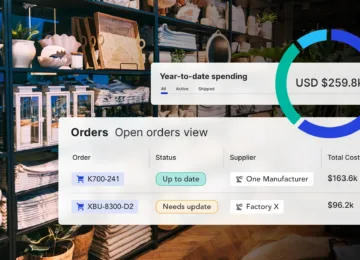Brands’ global supply chains are under more pressure than ever before. Since the onset of the Covid-19 pandemic, in particular, organizations have had to fend off an onslaught of disruptions that continue to threaten their financial health.
Labor and materials shortages, for example, have forced car manufacturers like Honda to reduce production output, clothing brands like Nike to cut sales output, and much of the food industry to hike prices. Meanwhile, tensions in Ukraine and Taiwan – both of which play vital roles in the global supply chain – are exacerbating the issue.
It’s because of the severity of these problems that the Federal Reserve Bank of New York began providing a Global Supply Chain Pressure Index (GSCPI) in May of 2022. The GSCPI aims to help businesses gain a more reliable picture of global supply chain conditions, as well as predict potential disruptions down the line that may impact their own business and the economy as a whole.
Indeed, the GSCPI helps brands add a much-needed element of predictability into what is otherwise a highly unpredictable aspect of their business. But it’s not enough to use it to just educate yourself on current supply chain conditions, nor is it enough to leverage the GSCPI to forecast changes. It’s vital that you leverage the data as actionable intelligence.
As a follow-up to our recent blog which aimed to increase your understanding of what the GSCPI is, we will now outline how you can use it to improve your supply chain management processes and preserve your organization’s financial health. Specifically, we’ll take a look at our top three tips to reduce escalating global supply chain pressures.
1. Clearing Up Transportation Jams
At Anvyl, we often hear how transportation jams and delayed shipments impact our customers. In fact, our proprietary data shows that 45% of our customers’ POs shipped late in 2022. Of these delayed shipments, 75% faced delays of over a week, 56% faced delays longer than 2 weeks, and 13% were delayed by more than 60 days.
The good news is that companies now have access to more tools that allow them to gain better control over their capacity planning process when products are in transit, by carefully tracking and monitoring shipments from every vendor.
Using our solution, for example, you can identify events that put your order ship date at risk with our machine-learning probability based assessment. This allows shipping managers and decision-makers to anticipate issues, adjust for potential delays, change shipment modes, and save time and money if any changes are needed.
2. Encouraging Supply Chain Resilience
Between wars, natural disasters, and the prolonged fallout of Covid-19, companies are desperate to mitigate persistent supply chain issues and preserve their profitability. Truthfully, much of the world has been in damage-control mode these past few years, leaving predictive planning and forecasting by the wayside. This has heightened the importance of boosting your resilience against supply chain issues by getting on top of them before they occur.
With modern supply chain management capabilities, companies have a tremendous capacity to obtain logistics visibility at all points of the supplier relationship. This advanced awareness of potential disruptions provides the opportunity to recover from them and maintain the desired continuity of operations.
According to an article by McKinsey & Company, some ways to increase your resilience include: focusing on short-term, day-to-day actions; implementing cross-silo efforts that ensure an agile response to fast-moving agents; integrating and streamlining your operations through actions such as creating a nerve center to consolidate responses to issues that arise; and taking action to build long-term resilience by doing things like testing “what if” scenarios and increasing data sharing with suppliers.
3. Managing Labor Shortages
Approximately 75% of American businesses alone have been affected by the current labor shortage, according to Provident Bank’s 2022 National Labor/Staffing Shortage Survey. Amongst the most impacted businesses are factories. And because they are so understaffed, it’s leading to production slowdowns and inventory stock-outs for distributors and retailers.
There are steps you can take to manage this labor mismatch in global logistics and supply chains, however. McKinsey & Company, for example, recommends a multi-part strategy that includes things like:
- Ensuring the long-term viability of the supplier base.
- Creating the capability to identify stressed nodes and adjust affected labor flows. Take measures to shift supply flow away from labor-stressed areas: reroute orders, use alternative shipment methods, or see if products could be manufactured in different locations.
- Redesigning products to reduce the need for labor-dependent components and materials.
- Exploring lean management and automation. More than 40% of employees spend at least a quarter of their time performing manual and repetitive tasks. Lean management can help reduce labor demand and allow employees to spend more time on higher-value, meaningful work.
- Engaging customers and suppliers on cost and service.
- Unlocking new sources of labor supply.
Boosting Your Supply Chain With Anvyl
Anvyl helps reduce the pressure of supply chain disruptions by improving supplier relationship management using state-of-the-art SRM technology. Anvyl is an intelligent PO management tool that facilitates real-time collaboration between teams, suppliers, and technology.
Our team has extensive experience in helping companies manage their supply chains better. Contact us today to learn how Anvyl can help your company seamlessly integrate your SCM applications.



